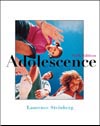| Major Section | Study Guide Features |
| | |
| Introduction | Learning Objective: 1 |
| | Important terms: peer groups Multiple choice questions: 1 Matching questions: 2 |
| | |
| I. The Origins of Adolescent Peer | Learning Objective: 1 |
| Groups in Contemporary Society | |
| | |
| A. The educational origins of | Learning Objective: 1 |
| adolescent peer groups | Important terms: age grading |
| | Multiple choice questions: 2 Fill in the blank questions: 1 Matching questions: 12 |
| | |
| B. Work, family life, and adolescent | Learning Objective: 1 |
peer groups | |
| | |
| C. Changes in the population | Learning Objective: 1 |
| | Important terms: baby boom Multiple choice questions: 3, 18 Fill in the blank questions: 2 Matching questions: 5, 13 |
| | |
| II. The Adolescent Peer Group: | Learning Objective: 2 |
| A Problem or a Necessity? | Multiple choice questions: 4 |
| | |
| | |
| A. Is there a separate youth culture? | Learning Objective: 2 |
| | Important terms: youth culture Fill in the blank questions: 3, 4 Matching questions: 14 |
| | |
| B. The need for peer groups in modern society | Learning Objective: 2 |
| | Important terms: particularistic norms, universalistic norms, postfigurative cultures, cofigurative cultures, prefigurative cultures Multiple choice questions: 5-8 Fill in the blank questions: 5-9 Matching questions: 3, 15, 16, 19, 20 |
| | |
| III. The Nature of Adolescent | Learning Objective: 3 |
| Peer Groups | Multiple choice questions: 26 |
| | |
| A. Changes in peer groups during adolescence | Learning Objective: 3 |
| | Important terms: significant others, sex cleavage Fill in the blank questions: 10 Matching questions: 7 |
| | |
| B. Cliques and crowds | Learning Objective: 4 |
| | Important terms: cliques, crowds Multiple choice questions: 9 Fill in the blank questions: 11-12 Matching questions: 8, 17 |
| | |
| C. Changes in clique and crowd structure | Learning Objective: 4 |
| over time | Important terms: participant observation |
| | Multiple choice questions: 10, 23, 24 Fill in the blank questions: 13 Matching questions: 6 |
| | |
| IV. Adolescents and Their Crowds | Learning Objective: 4 |
| | Multiple choice questions: 11 |
| | |
| A. The social map of adolescence | Learning Objective: 4 |
| | |
| B. Crowds as reference groups | Learning Objective: 4 |
| | Important terms: reference groups Multiple choice questions: 14, 21, 28 Fill in the blank questions: 14 |
| | |
| C. The scientific study of adolescence: | Learning Objective: 4 |
| How "nerds" become "normals" | Important terms: ethnography |
| | Multiple choice questions: 32 Fill in the blank questions: 15 |
| | |
| V. Adolescents and Their Cliques | Learning Objective: 4 |
| | Multiple choice questions: 12, 27 |
| | |
| A. Similarity among clique members | Learning Objective: 4 |
| | Important terms: social class Multiple choice questions: 13, 20, 22 Fill in the blank questions: 17 Matching questions: 4, 11 |
| | |
| B. The sexes: Why are there sex | Learning Objective: 4 |
| | differences in interracial contact? |
| | |
| C. Common interests among friends | Learning Objective: 4 |
| | |
| D. Similarity between friends: | Learning Objective: 4 |
| Selection or socialization | Important terms: iatrogenic effects |
| | Fill in the blank questions: 16, 18 Matching questions: 1 |
| | |
| VI. Popularity and Rejection in | Learning Objective: 5 |
| Adolescent Peer Groups | Important terms: relational aggression, |
| | hostile attribution bias Multiple choice questions: 15-17, 19, 25, 28, 30, 31, 33, 34 Fill in the blank questions: 19-20 Matching questions: 9, 10, 18 |
| | |
| VII. The Peer Group and | Learning Objective: 6 |
| Psychosocial Development | Multiple choice questions: 35 |



 2002 McGraw-Hill Higher Education
2002 McGraw-Hill Higher Education